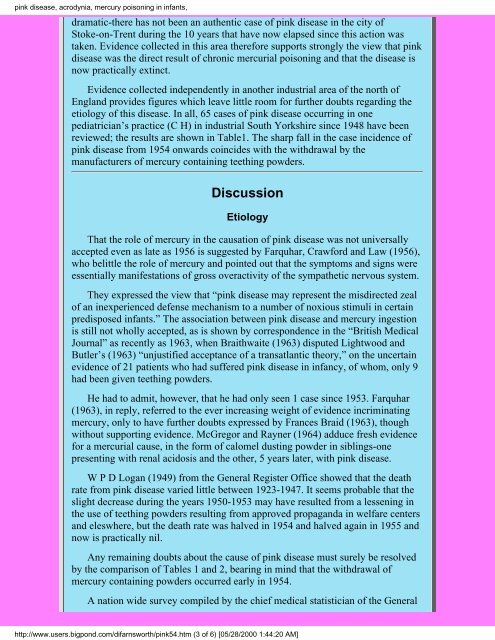You also want an ePaper? Increase the reach of your titles
YUMPU automatically turns print PDFs into web optimized ePapers that Google loves.
pink disease, acrodynia, mercury poisoning in infants,dramatic-there has not been an authentic case of pink disease in the city ofStoke-on-Trent during the 10 years that have now elapsed since this action wastaken. Evidence collected in this area therefore supports strongly the view that pinkdisease was the direct result of chronic mercurial poisoning and that the disease isnow practically extinct.Evidence collected independently in another industrial area of the north ofEngland provides figures which leave little room for further doubts regarding theetiology of this disease. In all, 65 cases of pink disease occurring in onepediatrician’s practice (C H) in industrial South Yorkshire since 1948 have beenreviewed; the results are shown in Table1. The sharp fall in the case incidence ofpink disease from 1954 onwards coincides with the withdrawal by themanufacturers of mercury containing teething powders.DiscussionEtiologyThat the role of mercury in the causation of pink disease was not universallyaccepted even as late as 1956 is suggested by Farquhar, Crawford and Law (1956),who belittle the role of mercury and pointed out that the symptoms and signs wereessentially manifestations of gross overactivity of the sympathetic nervous system.They expressed the view that “pink disease may represent the misdirected zealof an inexperienced defense mechanism to a number of noxious stimuli in certainpredisposed infants.” The association between pink disease and mercury ingestionis still not wholly accepted, as is shown by correspondence in the “British MedicalJournal” as recently as 1963, when Braithwaite (1963) disputed Lightwood andButler’s (1963) “unjustified acceptance of a transatlantic theory,” on the uncertainevidence of 21 patients who had suffered pink disease in infancy, of whom, only 9had been given teething powders.He had to admit, however, that he had only seen 1 case since 1953. Farquhar(1963), in reply, referred to the ever increasing weight of evidence incriminatingmercury, only to have further doubts expressed by Frances Braid (1963), thoughwithout supporting evidence. McGregor and Rayner (1964) adduce fresh evidencefor a mercurial cause, in the form of calomel dusting powder in siblings-onepresenting with renal acidosis and the other, 5 years later, with pink disease.W P D Logan (1949) from the General Register Office showed that the deathrate from pink disease varied little between 1923-1947. It seems probable that theslight decrease during the years 1950-1953 may have resulted from a lessening inthe use of teething powders resulting from approved propaganda in welfare centersand eleswhere, but the death rate was halved in 1954 and halved again in 1955 andnow is practically nil.Any remaining doubts about the cause of pink disease must surely be resolvedby the comparison of Tables 1 and 2, bearing in mind that the withdrawal ofmercury containing powders occurred early in 1954.A nation wide survey compiled by the chief medical statistician of the Generalhttp://www.users.bigpond.com/difarnsworth/pink54.htm (3 of 6) [05/28/2000 1:44:20 AM]


